Simple Steps for Identifying Confusing Brown Ducks—Females and Otherwise
November 21, 2014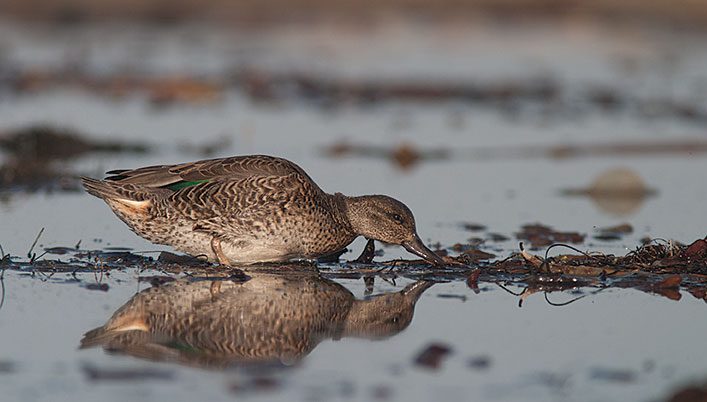
Ducks are fun to watch because they’re large, they sit out in the open, and the males are beautifully colorful. In fact breeding males are so distinctive that they draw many a birder’s attention away from the less colorful members of the flock. But taking a closer look at brown ducks can open a whole new level of appreciation, and can even add a few species to your day’s checklist.
A brown duck in late fall could be a female, an immature male, or even an adult male that hasn’t molted into his colorful plumage yet. To figure them out, you’ll want to look for anything that’s not brown—such as the wings—to reveal their identity. Let’s take the above picture as an example.
Step 1. What do we see?
Let’s use the four basic keys to bird identification—the four most important questions to go over in your mind as you look at a bird:
Size & Shape: this bird is clearly shaped like a duck with a chunky body and a wide, flat bill. The bill is fairly thin for a duck, and the bird has a fairly long body and short tail. There’s little else around for scale to help judge its size.
Color Pattern: The bird is brown with some gray tones, and it’s pretty much entirely patterned, with no blocks of solid color.
Behavior: It’s walking in shallow water, not swimming, and it’s picking food off the surface.
Habitat: It’s in a flooded crop field.
Step 2. To which group does this bird belong?
Okay, we know it’s a duck, and we know it’s snatching something from the surface. Ducks fall into two main categories—divers and dabblers. We wouldn’t see a diving duck walking to pick food off the surface, since they have legs positioned farther back on the body, making them very awkward on land. Dabbling ducks, on the other hand, are pros at searching for food in shallow water and mudflats.
And what if they’re on the water? Dabbling ducks tend to be taller at the stern than the more streamlined, tapered divers. Also, dabblers tend to be patterned with spots, streaks, and chevrons. Most divers are a more even shade of brown.
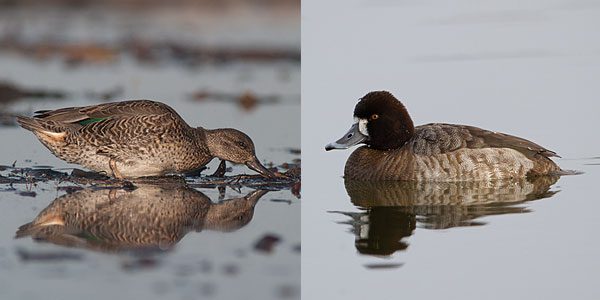
Step 3. Which species?
Now that we know this is a dabbling duck, we can narrow the species list. One species can be quickly ruled out based on Size & Shape: the Northern Shoveler’s enormous bill jumps out as distinctive no matter how confusingly brown the rest of the bird is.
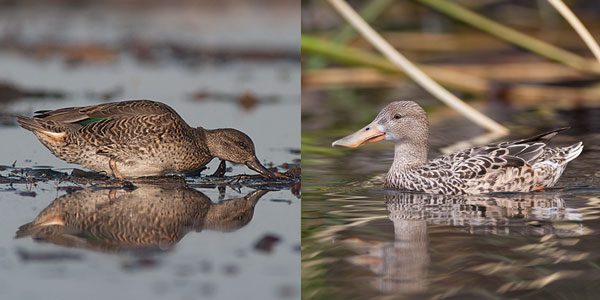
It always pays to consider the most common species in a group. Mallards are everywhere, but the females are fairly easy to confirm with their orange-and-black bills and their blue wing patch (speculum) bordered in white.
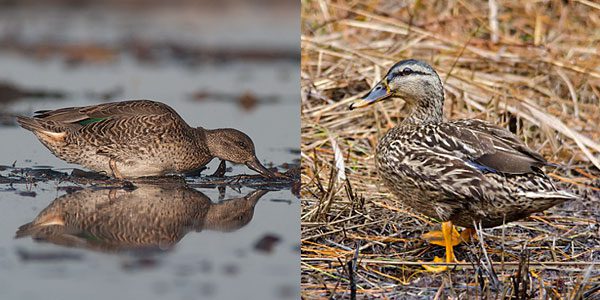
Northern Pintails are small dabbling ducks with a distinctive shape and color tone. It can take some practice, but look for their warm brown tones, graceful long neck, and relatively thin bill.
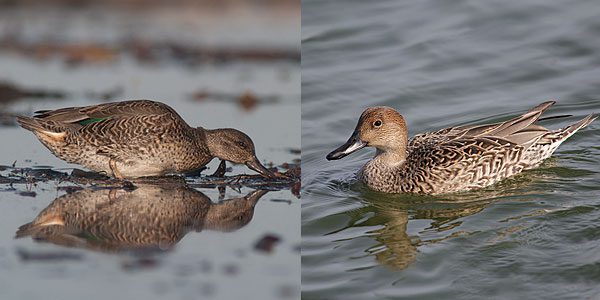
Blue-winged Teal (and Cinnamon Teal) have slightly larger bills and would lack the buffy stripe near the tail. These teal also have powder-blue patches on the wing, although this is often not visible when their wings are folded.
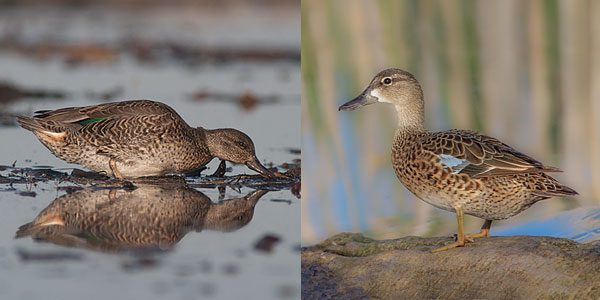
Coming back to the Color Pattern details we noticed earlier, this bird’s buffy stripe near the base of the tail and green peeking out in the wing point toward a Green-winged Teal. The green speculum is often hard to see on birds that aren’t flying, but that buffy stripe is nearly always visible, making it a valuable clue to remember.
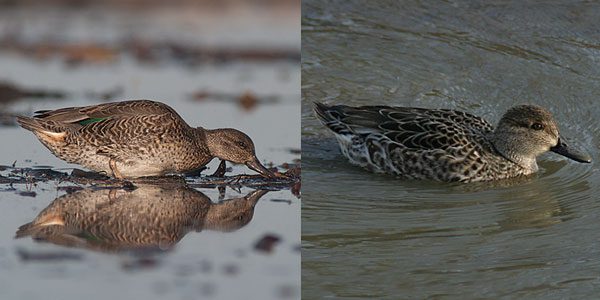
One final clue would have been size—if there had been other ducks in the photo to compare with. Green-winged Teal are astonishingly small ducks and in flocks their size difference is usually apparent.
There are a few other common dabbling duck species that it pays to look at when confronted with a brown duck: Gadwall, American Wigeon, American Black Duck—but we’ll leave those for you as a homework exercise. Looking at brown ducks is a great skill-builder that will have you picking up on subtler aspects of size, shape, and color in no time—not to mention enjoying those fine shades of brown and intricate feather patterns. Hope you enjoy!
More ways to have fun and build your identification skills:
- Get Free ID Help With Our New Merlin Bird ID App
- Sign up for a webinar or self-guided tutorial from our Education program
- Identify the Brown, Streaky Juvenile Songbirds of Summer With These Tips
- Use 4 Basic Keys Plus Migration Timing to Sort Out Your Thrushes
- Practice the four keys to bird ID on our Building Skills pages

All About Birds
is a free resource
Available for everyone,
funded by donors like you
American Kestrel by Blair Dudeck / Macaulay Library
